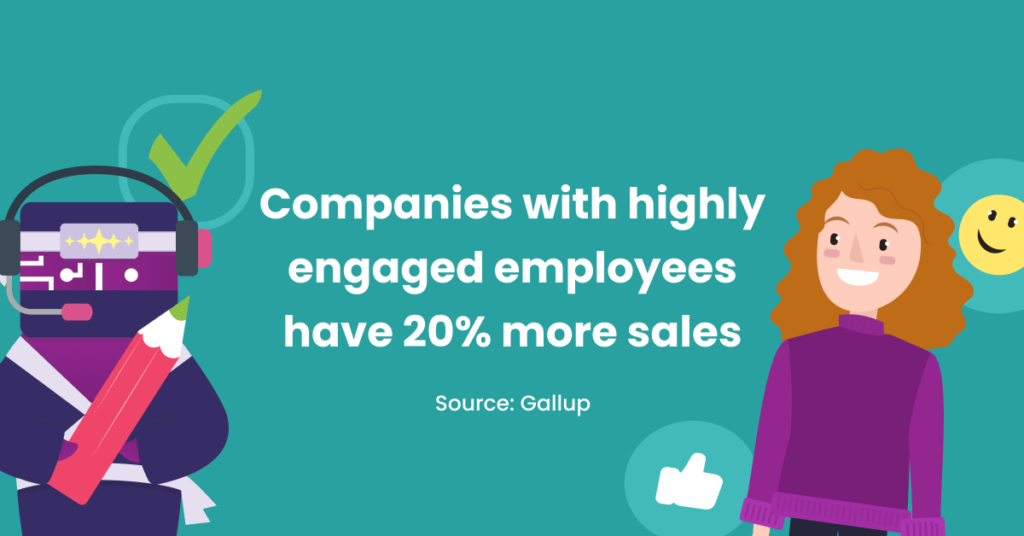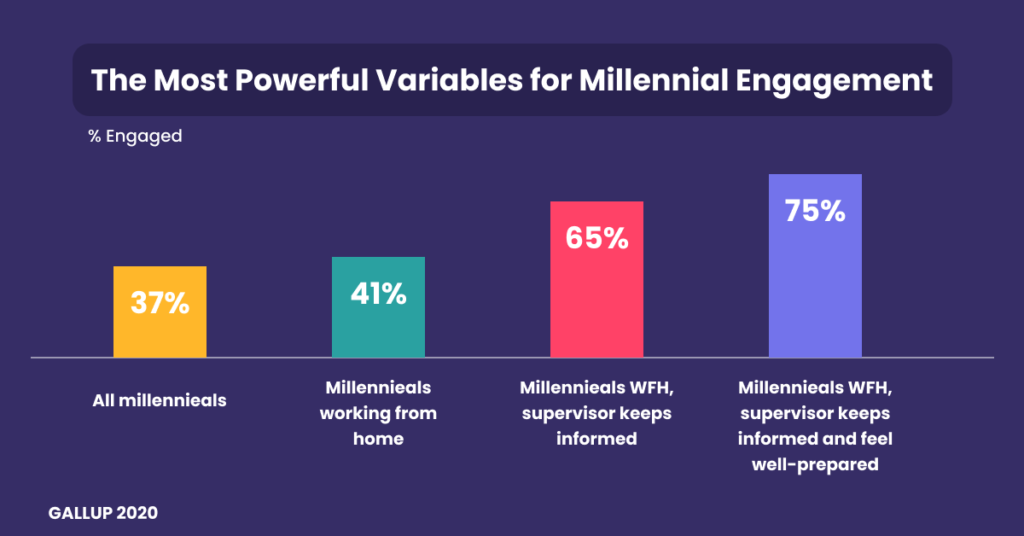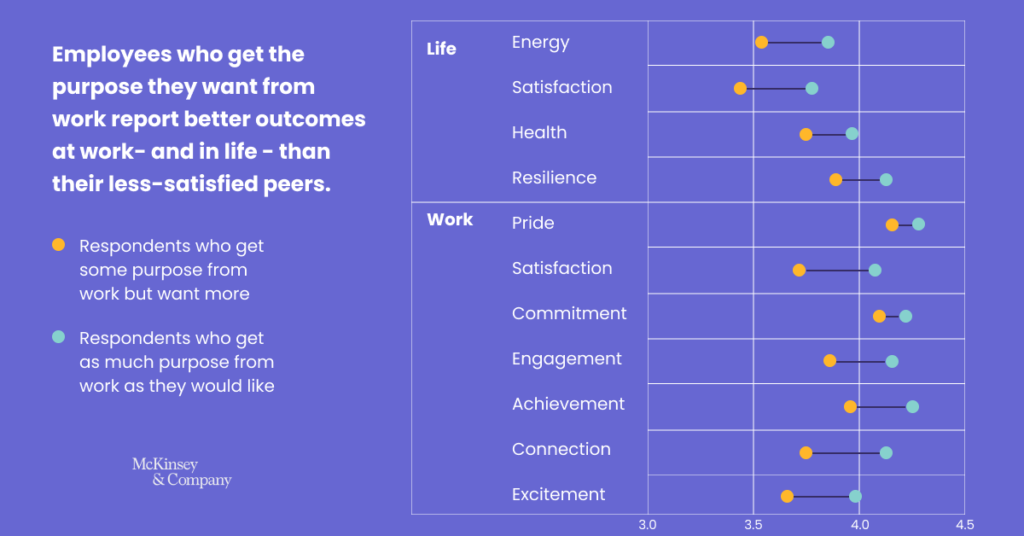Employee engagement statistics are more relevant than ever today — engaged agents bring engaged customers.
Engaged employees are the ones who will go the extra mile to make sure their customers are happy, and it’s becoming increasingly clear that companies that invest in engagement have a competitive advantage.
While it’s important for businesses to stay up-to-date on what’s going on in the world of engagement, it’s also helpful to look at some of the more interesting and surprising trends over time.
Some things may remain the same, but others will come as a surprise — like how employee engagement has steadily risen in the last few years.
We’ve rounded up 20+ statistics showing where employee engagement in customer service is standing right now and how it will continue to change in 2022.
What is employee engagement in customer service?

Employee engagement (or employee satisfaction) is the level of interest, commitment and engagement your employees feel for their jobs and the organization. It’s a combination of how happy your employees are with the things that impact their job satisfaction, like pay, benefits and workplace conditions. And it’s also about how hard they work and if they have a clear understanding of what you expect from them.
It is the emotional commitment of employees to the organization and its goals. A positive emotional attachment that leads to increased commitment, productivity, and performance.
Engaged employees are more likely to be committed to the organization’s goals, proud of what the company does, and enthusiastic about the products or services it provides.
It’s the point where the job isn’t just about the paycheck anymore.
What employee engagement is not
Employee engagement is not:
- Employee Happiness. Having happy employees is important. However, it does not always correlate with how invested they are in their work.
- Employee Wellbeing. Wellbeing can be a stepping stone to employee engagement. But being satisfied with the job is not synonymous to being so engaged that you’re willing to think outside the box to excel every day.

When is an employee engaged?
According to Deloitte, employees are more engaged when they:
- Feel they are doing meaningful work
- Have supportive management
- Perceive their work environment as positive
- Think they have growth opportunities
- Trust their leaders
Why are employee engagement statistics important?
Employee engagement is the driving force behind everything a company does, whether it’s delivering excellent customer service or making sure that your team has what they need to succeed in their work.
Your employees’ engagement level is determined by how they feel about their role and their relationship with the company. Engaged employees are motivated and happy, so they perform well and create great experiences for customers.

- A Gallup study found that companies with highly engaged employees have 20% more sales because their teams are more likely to go above and beyond to improve customer service.
This means that the investment in employee engagement pays off in a big way — employees who are able to give more of themselves lead to better experiences for the customers, which leads to increased brand loyalty and revenue.
The importance of employee engagement is not a new phenomenon, but the demand for it has grown thanks to the changing expectations of customers, who are now empowered by technology and social media to share their experiences with companies across the globe instantaneously.
The bottom line?
Customers want excellent customer service, and they’re willing to switch companies or take their business elsewhere if they don’t get it.
Engaged employees are vital in delivering quality customer service because they understand their role in the organization, have a sense of ownership over their work, and feel an emotional connection with their company’s purpose. These employees work hard for the business because they feel like it’s theirs. They have a direct line to customers through social media, so they can listen to and address customer concerns quickly. When employees are empowered to make decisions on behalf of the brand, that builds trust between the brand and the customer. This remains true whether they are remote or onsite employees
Here are some numbers to prove it.
Statistics around employee engagement in customer service
1. Engaged employees do not change jobs
After COVID hit and remote work became more popular, we entered the era of job changes; some people even nickname it “the great resignation” — employee resignation rates are rising.
- According to Harvard Business Review (via United States Bureau of Labor Statistic), the average customer service agent between the ages of 20 and 34 stays on the job for just over one year.
- In fact, the average call center turnover rate can reach as high as 45%—at least twice the average turnover in other departments, Quality Assurance & Training Connection says.
However, Gallup’s research has found that engaged employees stay on for longer.
- 74% of disengaged employees are looking for new employment or potential opportunities. At the same time, only 30% of engaged employees are looking for a change. Many variables affect the quit rates, such as general satisfaction and market opportunities. However, there is a strong correlation between employee engagement and resignation rates.
Therefore, retaining your employees is key for a working customer service strategy since the culture of service gets ingrained in the support agents only after some time.
2. Engaged employees don’t miss work
- Engagement statistics from Gallup report that engaged employees have 41% lower absenteeism, meaning productivity-wise engaged employees are more predictable and help you allocate your customer support shifts more efficiently.
Call center jobs are globally recognized for their high turnover rates, absenteeism, employee burnout, and emotional exhaustion, a study of call centers found. Agents are at constant risk of angry outbursts from customers, sexual harassment, and outright abuse.
A high amount of absenteeism or burnout can affect your staff’s availability. Low staffing can delay your customer’s calls or chats; you may experience longer waiting times or uncomfortable customers. And the list goes on.
3. Engaged employees make happy customers
Engaged employees will be more invested in their work and, therefore, take the time to service each client with empathy, increasing the customer service level of experience. Consumers want a personalized and unique customer experience on every contact.
- Engaged employees translate into 10% higher customer loyalty and engagement, Gallup found.
4. Happy customers recommend you

- Engaged employees provide excellent customer service experiences. And people who rate your company’s services as “good” are 38% more likely to recommend you!
- Bain & Company found proof that an NPS, Net Promoter Score, which shows how likely people are to recommend you to their friends and family, has a customer lifetime value that’s 600%-1,400% higher than a Detractor.
5. Keep millennials engaged
- Millennials’ engagement is currently up to 75% in 2021, from 35% in 2019.
Millennials are between 25 and 40 years now. The average age of a customer service representative is 40 years. Developing customer service engagement strategies that target this specific age group is, therefore, paramount for business success.
Here are some of the key variables that affect engagement: helping agents feel well-prepared, rewarding them for job well done, allowing remote work, and keeping them informed about what’s going on in the organization.

6. Wellbeing: If you care about them, they care about you (and your customers)
- More than half of employees who left their job in the past six months did not feel valued by their organization (54%) or manager (52%), or they lacked a sense of belonging — 51%, McKinsey found.
- In another research, McKinsey found that 46% cited the desire to work with people who trust and care for each other as another reason to quit. Employees want more robust relationships and a sense of connection.
7. Retention and employee engagement
As you would expect, a high turnover rate correlates with customer satisfaction. For this reason, having high retention rates is the better option, but how do you do that?
Keep our employees satisfied and engaged.
- Employee engagement survey statistics from McKinsey show that 61% of all respondents expect to be working with their company a year from now. In comparison, 19% indicated that they were likely to leave their current job. Among those likely to stay, nearly 60% are extremely happy with their job and company.
8. Employees want to be heard
- 64% of HR executives believe that a feedback tool that is always on is a vital part of an employee engagement listening program; however, just 20% have this type of tool, according to Achievers Workforce Institute.
Kaizo is just the tool that can help you keep your customer service agents engaged and motivated, enabling you to give them regular feedback and guidance based on data-driven insights.

9. Engaged employees make fewer mistakes
Employee engagement and productivity statistics show that engaged employees produce a better quality of work, but they also make fewer mistakes.
- A study conducted by Gallup showed that employee engagement significantly impacts call center mistakes. The study found that when employees were engaged, the number of errors dropped by 41%.
10. Purpose brings better performance outcomes
According to a recent study from McKinsey, employees who have a clear sense of purpose are more likely to provide better customer service.
As a manager, it’s your job to help your team find and understand their purpose at work. Purpose understanding can be done through coaching and mentorship, allowing them to set and reach goals that align with the company’s mission.
By doing this, you’ll not only improve customer service, but you’ll also create a more engaged, motivated, and proactive workforce. So next time you’re looking to improve performance, start by asking your team what their purpose is. Statistics show that it could make all the difference.

11. Training increases employee engagement
- The PMI showed that the eNPS increased from 54% to 61% after training for three months — a testament to the value training brings to learners in their day-to-day roles (which may be challenging to appreciate immediately after the learning experience).
Training is essential to increase employee engagement and customer satisfaction. Well-trained employees report higher concentration and service levels, leading to a significant NPS increase.
12. Use employee-oriented customer service
- Employee engagement statistics by PwC study shows that around 90% of C-suite leaders say they engage and take employees into account when choosing tools.
“When you don’t have a clear and accurate understanding of how your people use technology in their jobs and what they need and want from those tools, people’s overall experience at work can suffer.”
A bad employee experience can have a ripple effect on the organization, shaping everything from how engaged people are to their enthusiasm when delivering a customer service experience.
13. Customers appreciate engaged employees
A recent engagement statistics study by Salesforce says that customers appreciate it when employees are engaged and aware of sales interactions.
- An impressive 70% of customers said this is fundamental if companies want to keep their business. It is the responsibility of the manager to provide the tools and coaching so that employees are always aware of all interactions.
In today’s competitive market, that’s more important than ever for building customer loyalty and trust.
14. Well-trained employees are high performers

- Statistics around employee engagement show that 83% of high-performing service agents say they get the training they need to do their job well compared to only 52% of underperformers (Salesforce)
In other words, executives must nurture and promote training and coaching cultures to develop high performing customer service agents.
15. Disengaged employees drive the business away
- According to the PwC global employee engagement statistics, employees’ unfriendly service and a bad attitude can drive around 70% of the customers away.
Disengaged employees disengage customers by appearing uncaring and apathetic.
- That matters because Harvard professor Gerald Zaltman 95% of our purchase decisions are in the subconscious mind.
Agents might not know it, but their attitude and poor service greatly impact customer decisions.
Wrapping it up
Engagement numbers don’t lie — motivated and empowered agents deliver excellent customer service and increase business outputs.
Companies should focus on communication, training, development, and recognition to increase engagement. When employees feel like they are part of something larger and that their work matters, they are more likely to be engaged.
Book a demo with us to see how Kaizo can help you get your agents more invested in their work!


